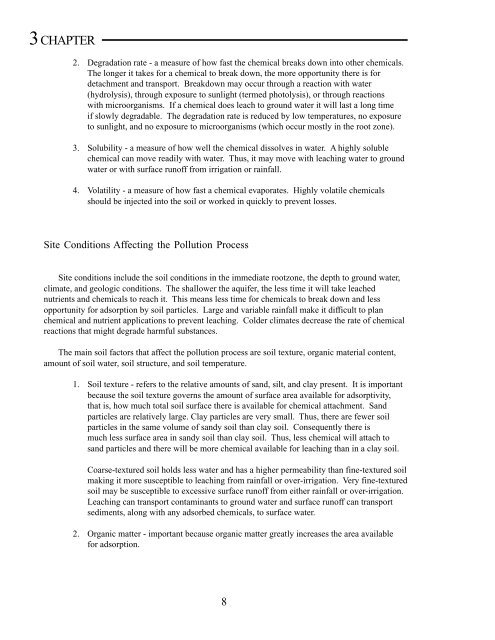Em4885 irrigation management practices to protect ground water
Em4885 irrigation management practices to protect ground water
Em4885 irrigation management practices to protect ground water
Create successful ePaper yourself
Turn your PDF publications into a flip-book with our unique Google optimized e-Paper software.
3 CHAPTER<br />
2. Degradation rate - a measure of how fast the chemical breaks down in<strong>to</strong> other chemicals.<br />
The longer it takes for a chemical <strong>to</strong> break down, the more opportunity there is for<br />
detachment and transport. Breakdown may occur through a reaction with <strong>water</strong><br />
(hydrolysis), through exposure <strong>to</strong> sunlight (termed pho<strong>to</strong>lysis), or through reactions<br />
with microorganisms. If a chemical does leach <strong>to</strong> <strong>ground</strong> <strong>water</strong> it will last a long time<br />
if slowly degradable. The degradation rate is reduced by low temperatures, no exposure<br />
<strong>to</strong> sunlight, and no exposure <strong>to</strong> microorganisms (which occur mostly in the root zone).<br />
3. Solubility - a measure of how well the chemical dissolves in <strong>water</strong>. A highly soluble<br />
chemical can move readily with <strong>water</strong>. Thus, it may move with leaching <strong>water</strong> <strong>to</strong> <strong>ground</strong><br />
<strong>water</strong> or with surface runoff from <strong>irrigation</strong> or rainfall.<br />
4. Volatility - a measure of how fast a chemical evaporates. Highly volatile chemicals<br />
should be injected in<strong>to</strong> the soil or worked in quickly <strong>to</strong> prevent losses.<br />
Site Conditions Affecting the Pollution Process<br />
Site conditions include the soil conditions in the immediate rootzone, the depth <strong>to</strong> <strong>ground</strong> <strong>water</strong>,<br />
climate, and geologic conditions. The shallower the aquifer, the less time it will take leached<br />
nutrients and chemicals <strong>to</strong> reach it. This means less time for chemicals <strong>to</strong> break down and less<br />
opportunity for adsorption by soil particles. Large and variable rainfall make it difficult <strong>to</strong> plan<br />
chemical and nutrient applications <strong>to</strong> prevent leaching. Colder climates decrease the rate of chemical<br />
reactions that might degrade harmful substances.<br />
The main soil fac<strong>to</strong>rs that affect the pollution process are soil texture, organic material content,<br />
amount of soil <strong>water</strong>, soil structure, and soil temperature.<br />
1. Soil texture - refers <strong>to</strong> the relative amounts of sand, silt, and clay present. It is important<br />
because the soil texture governs the amount of surface area available for adsorptivity,<br />
that is, how much <strong>to</strong>tal soil surface there is available for chemical attachment. Sand<br />
particles are relatively large. Clay particles are very small. Thus, there are fewer soil<br />
particles in the same volume of sandy soil than clay soil. Consequently there is<br />
much less surface area in sandy soil than clay soil. Thus, less chemical will attach <strong>to</strong><br />
sand particles and there will be more chemical available for leaching than in a clay soil.<br />
Coarse-textured soil holds less <strong>water</strong> and has a higher permeability than fine-textured soil<br />
making it more susceptible <strong>to</strong> leaching from rainfall or over-<strong>irrigation</strong>. Very fine-textured<br />
soil may be susceptible <strong>to</strong> excessive surface runoff from either rainfall or over-<strong>irrigation</strong>.<br />
Leaching can transport contaminants <strong>to</strong> <strong>ground</strong> <strong>water</strong> and surface runoff can transport<br />
sediments, along with any adsorbed chemicals, <strong>to</strong> surface <strong>water</strong>.<br />
2. Organic matter - important because organic matter greatly increases the area available<br />
for adsorption.<br />
8
















